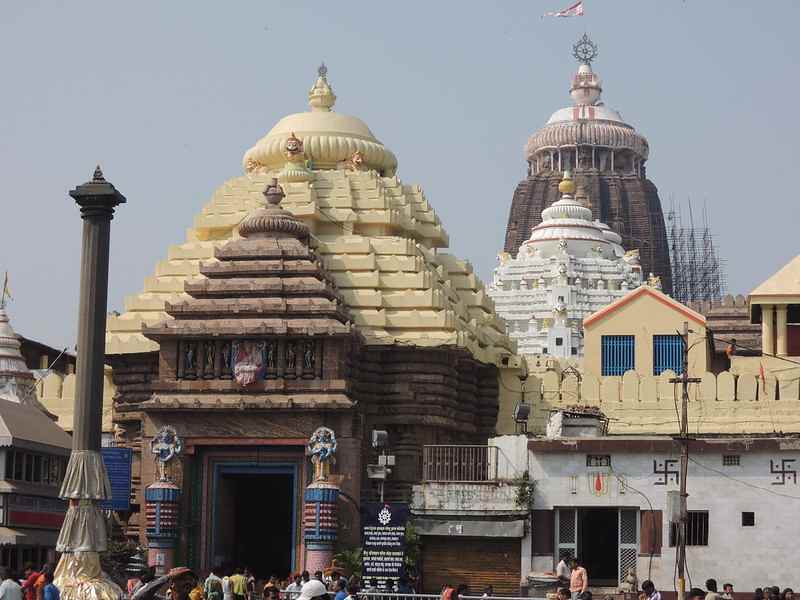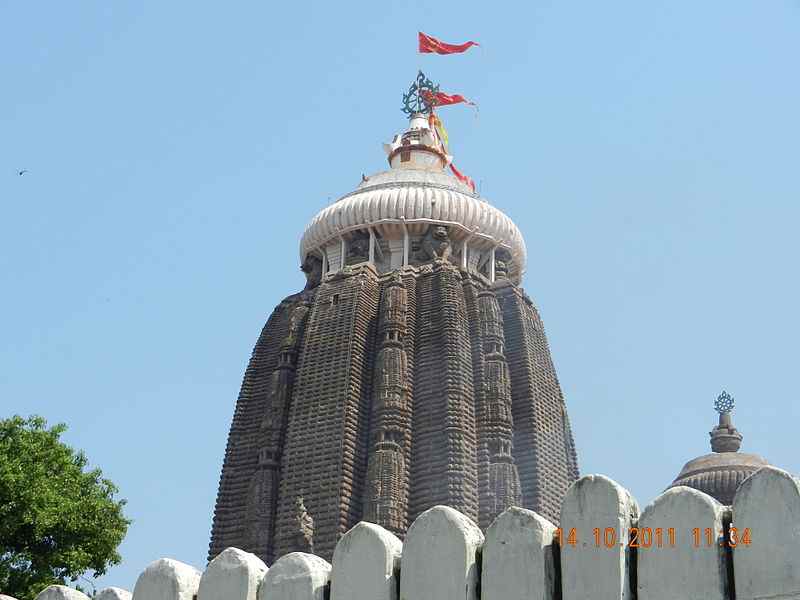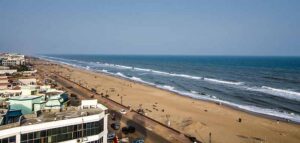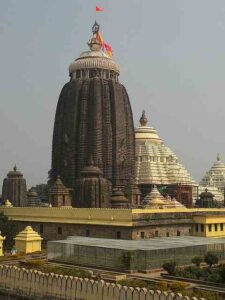The Jagannath Temple is an important Hindu temple in Puri in the state of Odisha on the eastern coast of India. Puri is a seaside pilgrimage city on the Bay of Bengal. The Jagannath temple story has been mentioned in Puranas. The Puri temple is famous for its annual Ratha Yatra, or chariot festival, in which the deities are taken out from the temple and placed in large chariots. A sea of people pulls these huge and elaborately decorated temple cars.

Puri is one of the Char Dhams. As per Hindu traditions, Char Dhams are situated in four directions of India. Rameshwaram in the south, Puri Jagannath temple in the east, Dwaraka in the west, and Badrinath in the north.
Legend has it, Lord Vishnu take bath in Badrinath, changes clothes in Dwaraka, have food at Puri mandir, and then takes rest at Rameshwaram.
In the Puri temple, Lord Jagannath is not installed alone. But It is part of a triad of deities that includes his brother Balabhadra and his sister Subhadra. Of these, Balabhadra is identified with Balarama, the brother of Krishna. Subhadra is said to be the goddess Bhubaneshwari.
Jagannath temple story
According to legend, King Indradyumna started the construction of the first Jagannath temple.
The legendary account as found in the Puranas and later Odia works states that Lord Jagannath was originally worshipped in the form of Neela Madhaba, an image of Narayana made of bluestone.
A tribal chief named Viswavasu worshipped Him secretly in a dense forest. Having heard about the deity, King Indradyumna sent a Brahmin priest, Vidyapati, to locate the idol.
Vidyapati was unable to find the place. But at last, he married Viswavasu’s daughter Lalita. At the repeated request of Vidyapti, Viswavasu took his son-in-law blindfolded to a cave where Lord Neela Madhaba was worshipped.
Vidyapati, an intelligent man, dropped mustard seeds on the ground on the way. After a few days, the seeds germinated, which enabled him to find out the cave.
On hearing from him, King Indradyumna proceeded immediately to Odra desha (Odisha) to see and worship the deity. But, to his dismay, the idol had disappeared. It was hidden in the sand.
The disappointed King was determined to not return without having a darshan of the deity. He observed fast unto death at Mount Neela. Then, a celestial voice cried, ‘thou shalt see him.’ Afterward, the King performed a horse sacrifice. He built a magnificent temple for Vishnu and installed a Narasimha Murti brought by Narada in the temple.
One day, during sleep, the King had a vision of Lord Jagannath. Also, a divine voice directed him to make idols from a log found on the seashore.
The King found the log of wood. But none of the carpenters were able to make a dent in the wood.
Then Lord Vishwakarma took the form of an old carpenter and told the King that he would prepare the idols. But, he will do the work in a closed room, and nobody will disturb him.
For some days, there was no sound coming from the temple. The queen became anxious. She thought that the carpenter is dead and compelled the King to open the door.
Thus, they went to see the carpenter at work. He abandoned his work leaving the idols unfinished.
The idol was devoid of any hands. But a divine voice instructed Indradyumana to install them in the temple.
As per the copper plate inscriptions, temple construction started somewhere in the 12th century. The present temple was rebuilt on the site of an earlier temple. Anantavarman Chodaganga Deva, the King of Kalinga from the Eastern Ganga dynasty, began the work.
According to the temple chronicle, the son of Anantavarman, Anangabhima-deva II, completed the construction work. He brought the temple to its current form.
The temple complex was further developed during the reigns of the subsequent Kings.
Architecture Of Jagannath Temple
The massive temple complex is spread over 400,000 square feet and is surrounded by a high fortified wall.
The temple was built based on Oriya architecture. The main temple is 214 feet(equivalent to 45 storey building) in height.

There is a Neel chakra at the top of the temple. It is made of ashtadhatu(an alloy of eight metals). As per custom, every day, a different flag is waved on the Nila Chakra. The flag hoisted on the Nila Chakra is called the Patita Pavana (Purifier of the Fallen). It is visible from any part of the city.
There are at least 120 temples and shrines inside the complex. The Bimala Temple, a Shakti pith, is considered one of the most important among them. Hindu mythology says that the feet of Goddess Sati have fallen on the spot where the temple is constructed. Food is offered to Jagannath and Goddess Vimala then only it is considered Mahaprasad.
Lord Jagannath is offered food six times a day. The temple’s kitchen is the largest in the world.
56 varieties of vegetarian food are prepared without onions, garlic, or chillis, as prescribed by Hindu religious texts. Cooking is done only in earthen pots. After the usage pots are broken. The water is drawn from the wells near the kitchen called Ganga and Yamuna. The Mahaprasad of Lord Jagannath is distributed amongst the devotees.
Madala Panji has a record of all the events that happened in the temple. The accounts suggest that the Puri Jagannath temple has been invaded and plundered eighteen times. During this invasion, the deities were hidden in the villages.
In 1692, Mughal emperor Aurangzeb ordered to close the temple. It re-opened after Aurangzeb died in 1707.
In the history of India, during the Muslim invasion, they managed to build a mosque at sacred Hindu places such as Ayodhya, Kasi, and Mathura. But, the Jagannath temple remained standstill at the time of the invasion, and no mosque had been erected. The servitors and the subsequent Kings have played a crucial role in safeguarding the deities at the time of danger.
The temple is open from 5:00 am to midnight. Non-Hindus are not permitted to enter the temple.





[…] According to Agni Purana, the Sudarshan Chakra of Lord Vishnu after being cursed for its ego, the Lord blessed it to be worshipped with Lord Jagannath. Read the full story of the Jagannath temple from the time of Puranas. […]
[…] city of Puri is a sacred place as one of the Char Dhams, Jagannath temple is there. Read the story of the Jagannath temple from the time of Puranas and the mysteries surrounding the Jagannath temple. Pilgrims take a purification dip at Puri sea […]
[…] Also Read: The story of Jagganath Temple, Puri, from the time of Puranas […]